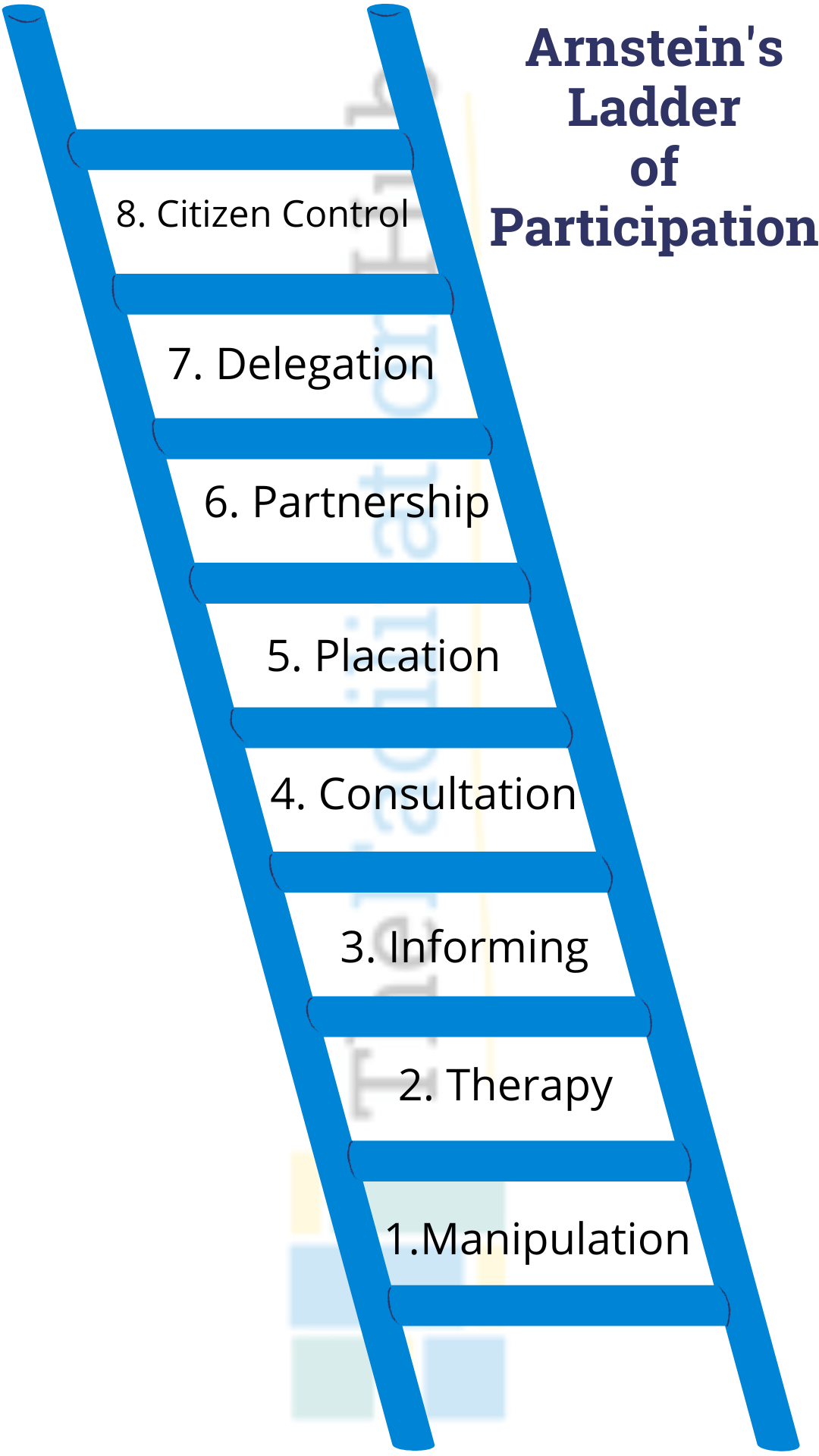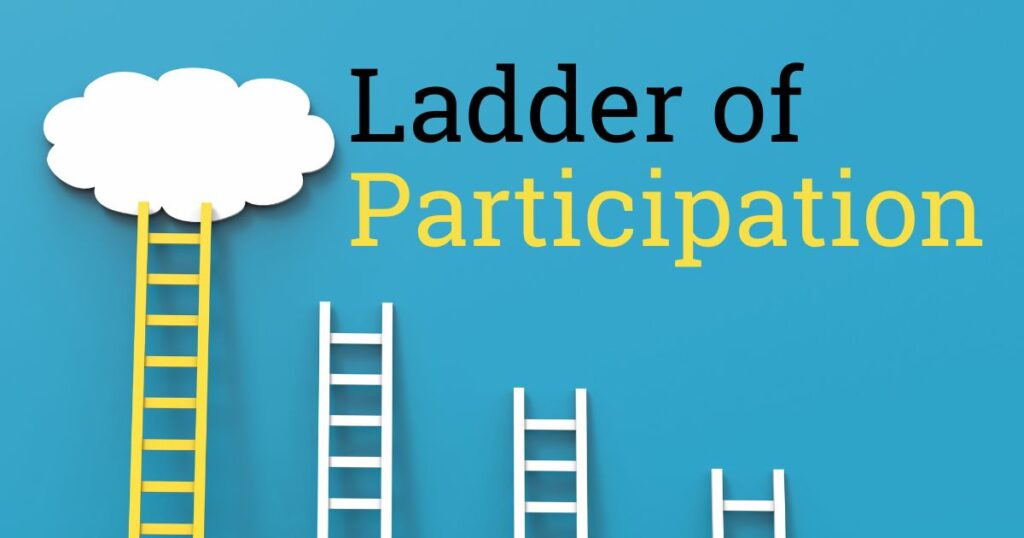Are you looking for a way to measure the level of citizen participation and ensure that your community is being heard? Look no further! Today, we’re diving into Arnstein’s Ladder of Participation, a powerful tool that can help you understand and improve citizen involvement in your work.
Whether you’re a seasoned professional or just starting out, this model is sure to provide valuable insights and inspiration for making your decision-making processes more democratic and inclusive.
So grab a cup of coffee, get comfy, and let’s get started!
Contents
What Is Arnstein’s Ladder of Participation?
Arnstein’s Ladder of Participation is a tool used in community development to measure the level of citizen participation in decision-making processes. Developed by Sherry Arnstein in 1969, the ladder has eight rungs that range from “manipulation” to “citizen control”.
Citizen participation is all about changing the way we politicians, developers, and regular folk work together to make big decisions. And there’s plenty of ways for the local peeps to get in on the action. We wanna give you some inspiration for what’s already been done and some ideas for where to focus your energy.
Good participation = good democracy.
When people get involved in politics, they start to feel responsible for what’s going on around them. The same goes for planning – people get invested in their neighborhoods and have a sense of ownership, which helps build trust with decision-makers over time.
But what does good citizen participation in planning really look like? It’s a tough question, but Arnstein’s ladder can help answer it. It’s a model that shows how citizen participation affects public perceptions of legitimacy, authority, and good governance.
The higher up the ladder you go, the better the level of participation.
Do you ever feel like your voice isn’t being heard in community decisions that affect you? Well, Arnstein’s Ladder is here to help! It’s like a map to guide you on your journey from being a passive spectator to a full-fledged co-creator of change.
The Rungs On The Ladder Of Participation
Let’s climb the rungs together:
- Manipulation: At the bottom of the ladder, we have “manipulation.” This is when decision-makers pretend to involve citizens but actually have no intention of listening to their opinions. It’s like a mirage in the desert, it looks like you’re making progress but you’re actually not.
- Therapy: In the next rung, we have “therapy.” This is when citizens are allowed to vent their emotions but their opinions are not acted upon. It’s like talking to a brick wall – you feel better, but nothing changes.
- Informing: This rung is about “informing.” Citizens are given information about decisions, but they have no say in the outcome. It’s like reading the news, you’re informed but your opinion doesn’t matter.
- Consultation: Here we have “consultation.” citizens are asked for their opinions but the decision-makers still have the final say. It’s like giving a suggestion in a restaurant, the chef may listen but still decides what to cook.
- Placation: A level of participation where citizens are given token gestures or superficial opportunities for input, but their suggestions or recommendations are not taken seriously or incorporated into decision-making.
- Partnership: This is where “partnership” comes in. Both decision-makers and citizens work together to reach a solution. It’s like a dance, everyone is moving together towards a common goal.
- Delegated Power: In this rung, decision-making power is partially transferred to citizens. It’s like lending someone your car, you trust them with a valuable asset.
- Citizen Control: The top of the ladder is “citizen control.” This is when citizens have the final say in decision-making processes. It’s like being the captain of your own ship, you’re in control of your own journey.

Now that we’ve climbed the ladder, let’s ask ourselves, where are we on the journey to true citizen participation? Let’s strive for the top rung of citizen control and make our voices heard!
See also: Reflective practice for facilitators
How do you measure where you currently are on the Ladder of Participation?
Measuring where you are on Arnstein’s ladder of participation is all about assessing the level of power and influence that citizens have in decision-making processes.
The ladder consists of eight rungs, each representing a different level of participation, from “nonparticipation” at the bottom to “citizen control” at the top.
To determine your current rung, you can consider factors such as the level of decision-making authority given to citizens, the degree of information sharing and transparency, and the extent to which citizen inputs are integrated into the final decision.
Some experts suggest using a rubric or a set of criteria to objectively evaluate the level of citizen participation in a particular decision-making process.
It’s important to keep in mind that the ladder is a dynamic model, and the level of participation can change over time as the circumstances change. So, measuring where you are on the ladder is not a one-time thing, but an ongoing process of reflection and improvement.
What other similar models are there to measure Citizen Participation?
There are several other models that aim to measure and promote citizen participation, including:
- Deliberative Democracy: This model emphasizes active and informed public engagement in decision-making processes. It values the exchange of ideas, respectful dialogue, and the consideration of multiple perspectives.
- The Political Participation Spectrum: This model outlines different forms of political participation, ranging from passive to active engagement, and is often used to evaluate the level of citizen engagement in a particular political system.
- The Four Types of Political Participation: This model categorizes political participation into four types: electoral, institutional, non-institutional, and behavioral. It highlights the different ways in which citizens can participate in the political process and emphasizes the importance of diverse forms of engagement.
- The Community Participation Matrix: This model outlines different levels of community involvement in decision-making processes, from consultation to co-creation. It is often used in the context of community development and planning.
Each of these models offers a unique perspective on citizen participation and can be useful in different contexts.
The most appropriate model for a particular situation will depend on the goals and objectives of the decision-making process, as well as the level of engagement and power dynamics between citizens and decision-makers.
Final Thoughts
We’ve covered a lot about Arnstein’s Ladder of Participation and how it can help you better understand and improve citizen engagement in your decision-making processes. It’s a valuable tool for anyone working in the public sector and a great starting point for making changes that can have a positive impact on your community.
It’s important to take small steps and continuously evaluate your progress.
So, let’s all make a commitment to putting Arnstein’s Ladder into practice in our work. By doing so, we can ensure that our communities are heard, that their input is valued, and that their lives are improved.
Let’s work together to build a more democratic and inclusive society, one ladder rung at a time!



